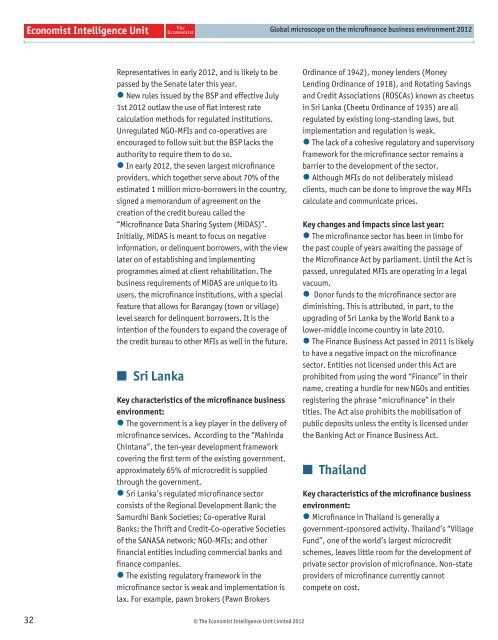Global microscope on the microfinance business environment 2012
Global microscope on the microfinance business environment 2012
Global microscope on the microfinance business environment 2012
Create successful ePaper yourself
Turn your PDF publications into a flip-book with our unique Google optimized e-Paper software.
32<br />
Representatives in early <strong>2012</strong>, and is likely to be<br />
passed by <strong>the</strong> Senate later this year.<br />
l New rules issued by <strong>the</strong> BSP and effective July<br />
1st <strong>2012</strong> outlaw <strong>the</strong> use of fl at interest rate<br />
calculati<strong>on</strong> methods for regulated instituti<strong>on</strong>s.<br />
Unregulated NGO-MFIs and co-operatives are<br />
encouraged to follow suit but <strong>the</strong> BSP lacks <strong>the</strong><br />
authority to require <strong>the</strong>m to do so.<br />
l In early <strong>2012</strong>, <strong>the</strong> seven largest microfi nance<br />
providers, which toge<strong>the</strong>r serve about 70% of <strong>the</strong><br />
estimated 1 milli<strong>on</strong> micro-borrowers in <strong>the</strong> country,<br />
signed a memorandum of agreement <strong>on</strong> <strong>the</strong><br />
creati<strong>on</strong> of <strong>the</strong> credit bureau called <strong>the</strong><br />
“Microfi nance Data Sharing System (MiDAS)”.<br />
Initially, MiDAS is meant to focus <strong>on</strong> negative<br />
informati<strong>on</strong>, or delinquent borrowers, with <strong>the</strong> view<br />
later <strong>on</strong> of establishing and implementing<br />
programmes aimed at client rehabilitati<strong>on</strong>. The<br />
<strong>business</strong> requirements of MiDAS are unique to its<br />
users, <strong>the</strong> microfi nance instituti<strong>on</strong>s, with a special<br />
feature that allows for Barangay (town or village)<br />
level search for delinquent borrowers. It is <strong>the</strong><br />
intenti<strong>on</strong> of <strong>the</strong> founders to expand <strong>the</strong> coverage of<br />
<strong>the</strong> credit bureau to o<strong>the</strong>r MFIs as well in <strong>the</strong> future.<br />
■ Sri Lanka<br />
Key characteristics of <strong>the</strong> microfi nance <strong>business</strong><br />
envir<strong>on</strong>ment:<br />
l The government is a key player in <strong>the</strong> delivery of<br />
microfi nance services. According to <strong>the</strong> “Mahinda<br />
Chintana”, <strong>the</strong> ten-year development framework<br />
covering <strong>the</strong> fi rst term of <strong>the</strong> existing government,<br />
approximately 65% of microcredit is supplied<br />
through <strong>the</strong> government.<br />
l Sri Lanka’s regulated microfi nance sector<br />
c<strong>on</strong>sists of <strong>the</strong> Regi<strong>on</strong>al Development Bank; <strong>the</strong><br />
Samurdhi Bank Societies; Co-operative Rural<br />
Banks; <strong>the</strong> Thrift and Credit-Co-operative Societies<br />
of <strong>the</strong> SANASA network; NGO-MFIs; and o<strong>the</strong>r<br />
fi nancial entities including commercial banks and<br />
fi nance companies.<br />
l The existing regulatory framework in <strong>the</strong><br />
microfi nance sector is weak and implementati<strong>on</strong> is<br />
lax. For example, pawn brokers (Pawn Brokers<br />
© The Ec<strong>on</strong>omist Intelligence Unit Limited <strong>2012</strong><br />
<str<strong>on</strong>g>Global</str<strong>on</strong>g> <str<strong>on</strong>g>microscope</str<strong>on</strong>g> <strong>on</strong> <strong>the</strong> microfi nance <strong>business</strong> envir<strong>on</strong>ment <strong>2012</strong><br />
Ordinance of 1942), m<strong>on</strong>ey lenders (M<strong>on</strong>ey<br />
Lending Ordinance of 1918), and Rotating Savings<br />
and Credit Associati<strong>on</strong>s (ROSCAs) known as cheetus<br />
in Sri Lanka (Cheetu Ordinance of 1935) are all<br />
regulated by existing l<strong>on</strong>g-standing laws, but<br />
implementati<strong>on</strong> and regulati<strong>on</strong> is weak.<br />
l The lack of a cohesive regulatory and supervisory<br />
framework for <strong>the</strong> microfi nance sector remains a<br />
barrier to <strong>the</strong> development of <strong>the</strong> sector.<br />
l Although MFIs do not deliberately mislead<br />
clients, much can be d<strong>on</strong>e to improve <strong>the</strong> way MFIs<br />
calculate and communicate prices.<br />
Key changes and impacts since last year:<br />
l The microfi nance sector has been in limbo for<br />
<strong>the</strong> past couple of years awaiting <strong>the</strong> passage of<br />
<strong>the</strong> Microfi nance Act by parliament. Until <strong>the</strong> Act is<br />
passed, unregulated MFIs are operating in a legal<br />
vacuum.<br />
l D<strong>on</strong>or funds to <strong>the</strong> microfi nance sector are<br />
diminishing. This is attributed, in part, to <strong>the</strong><br />
upgrading of Sri Lanka by <strong>the</strong> World Bank to a<br />
lower-middle income country in late 2010.<br />
l The Finance Business Act passed in 2011 is likely<br />
to have a negative impact <strong>on</strong> <strong>the</strong> microfi nance<br />
sector. Entities not licensed under this Act are<br />
prohibited from using <strong>the</strong> word “Finance” in <strong>the</strong>ir<br />
name, creating a hurdle for new NGOs and entities<br />
registering <strong>the</strong> phrase “microfi nance” in <strong>the</strong>ir<br />
titles. The Act also prohibits <strong>the</strong> mobilisati<strong>on</strong> of<br />
public deposits unless <strong>the</strong> entity is licensed under<br />
<strong>the</strong> Banking Act or Finance Business Act.<br />
■ Thailand<br />
Key characteristics of <strong>the</strong> microfi nance <strong>business</strong><br />
envir<strong>on</strong>ment:<br />
l Microfi nance in Thailand is generally a<br />
government-sp<strong>on</strong>sored activity. Thailand’s “Village<br />
Fund”, <strong>on</strong>e of <strong>the</strong> world’s largest microcredit<br />
schemes, leaves little room for <strong>the</strong> development of<br />
private sector provisi<strong>on</strong> of microfi nance. N<strong>on</strong>-state<br />
providers of microfi nance currently cannot<br />
compete <strong>on</strong> cost.















![Joint Report on Social Protection and Social Inclusion [2005]](https://img.yumpu.com/19580638/1/190x132/joint-report-on-social-protection-and-social-inclusion-2005.jpg?quality=85)
